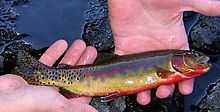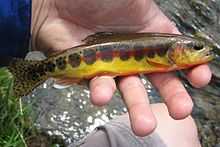Golden trout
| Golden trout | |
|---|---|
 | |
| Conservation status | |
| Not evaluated (IUCN 3.1) | |
| Scientific classification | |
| Kingdom: | Animalia |
| Phylum: | Chordata |
| Class: | Actinopterygii |
| Order: | Salmoniformes |
| Family: | Salmonidae |
| Genus: | Oncorhynchus |
| Species: | O. mykiss |
| Subspecies: | O. m. aguabonita O. m. gilberti O. m. whitei |
| Trinomial name | |
| Oncorhynchus mykiss aguabonita (Jordan, 1892)[1] | |
The golden trout or California golden trout (Oncorhynchus mykiss aguabonita) is a sub-species of the rainbow trout native to California. It closely resembles the juvenile rainbow trout. The golden trout is native to Golden Trout Creek (tributary to the Kern River, Volcano Creek (tributary to Golden Trout Creek), and the South Fork Kern River. A sibling subspecies, Little Kern golden trout (O. m. whitei), was historically found only in the Little Kern River but is now found in other nearby creeks, as well. Another sibling subspecies, Kern golden trout or Kern River rainbow trout (O. m. gilberti), was once widely distributed in the Kern River system, but was reduced to a limited section until transplantation to other creeks.[2] The golden trout was designated the state fish of California in 1947.[3]


Taxonomy
Originally placed in the species Oncorhynchus aguabonita taxonomists now classify the golden trout as a subspecies of the rainbow trout, Oncorhynchus mykiss, placing it with several other subspecies commonly known as redband trout, Oncorhynchus mykiss ssp.
ITIS has recognized the subspecies O. m. whitei[4] and O. m. gilberti,[4] but not O. m. aguabonita, which it maintains is the species O. aguabonita.[5][1]
Description
The golden trout has golden flanks with red, horizontal bands along the lateral lines on each side and about 10 dark, vertical, oval marks (called "parr marks") on each side. Dorsal, lateral and anal fins have white leading edges. In their native habitat, adults range from 6–12 in (15–30 cm) long. Fish over 10 in (25 cm) are considered large. Golden trout that have been transplanted to lakes have been recorded up to 11 lb (5 kg) in weight.
The golden trout should be distinguished from the similarly named golden rainbow trout, also known as the palomino trout. The golden rainbow is a color variant of the rainbow trout.[6]
The golden trout is commonly found at elevations from 6,890 feet (2,100 m) to 10,000 feet (3,000 m) above sea level, and is native only to California's southern Sierra Nevada mountains.[7] Preferred water temperature is 58–62 °F (14–17 °C) but they can tolerate temperatures in degraded streams on the Kern Plateau as high as 70 °F (21 °C) so long as those waters cool during the night.[7] The only other species of fish indigenous to the native range of California golden trout is the Sacramento sucker (Catostomus occidentalis occidentalis).[8]
Record Catches
The Wyoming Game & Fish Department state record golden trout measured 28 in (71 cm) and weighed 11.25 lb (5.10 kg), caught in Cook Lake, Wyoming in 1948.[9] The IGFA “All-Tackle Length Record” for O. m. aguabonita measured 21 in (53 cm) caught in Golden Lake, Wyoming in 2012.[10]
Distribution
O. m. aguabonita is native to the southern Sierra Nevada, including the upper reach and tributaries of the South Fork of the Kern River, and Golden Trout Creek and its tributaries.[11] It has been introduced in hundreds of lakes and streams outside the native range, though most of these populations did not last or hybridized with cutthroat trout and other subspecies of rainbow trout.[11] Distribution data that may be incomplete or inaccurate includes the Canadian province of Alberta, and the US states of Arizona, California, Colorado, Idaho, Montana, New Mexico, Nevada, Oregon, Utah, Washington, and Wyoming.[11]
O. m. gilberti was once widely distributed in the Kern River system in California.[12] It now occurs in the Kern River from Durrwood Creek to Junction Meadow, with established transplanted populations in Rattlesnake Creek, Osa Creek, and possibly upper Peppermint Creek and others.[12]
O. m. whitei is native to the Little Kern River in Tulare County, California, where it still occurs above the falls on the lower river.[13]
History
In 1892 the California golden trout was originally described by David Starr Jordan, the first President of Stanford University, as Salmo mykiss agua-bonita. The fish was named after the Agua Bonita Waterfall where the first specimens were collected, at the mouth of Volcano Creek, at the creek's confluence with the Kern River.[14] A century later they were listed as Oncorhynchus mykiss aguabonita in Behnke's Native trout of western North America.[15]
In 1904 Stewart Edward White communicated to his friend President Theodore Roosevelt, that overfishing could lead to extinction of the golden trout. In White's novel The Mountains, he wrote about the threatened golden trout on California’s Kern Plateau. Roosevelt shared White’s concern and, through U.S. Fish Commissioner George M. Bowers, dispatched biologist Barton Warren Evermann of the U.S. Bureau of Fisheriest to study the situation. In 1906 Evermann published The Golden Trout of the Southern High Sierras.[16] Based on morphology, Evermann accurately described four forms of this native fish: Salmo roosevelti from Golden Trout (Volcano) Creek, Salmo aguabonita from nearby South Fork of the Kern River, Salmo whitei (named in recognition of Stewart Edward White) from the Little Kern River, and Salmo gilberti, the Kern River rainbow.[8]
Genetic studies have since clarified three groups of trout native to the Kern River: California golden trout (O. m. aguabonita) native to the South Fork Kern River and Golden Trout Creek (tributary to the Kern River mainstem but the historic course of the South Fork Kern River and now only separated from it by a lava flow and ridge of sediment), Little Kern River golden trout (O. m. whitei), and Kern River rainbow trout (O. m. gilberti).[17]
Conservation
Years of overexploitation, mismanagement and competition with exotic species have brought golden trout to the brink of being designated as "threatened".[<span title="Designated by whom? Which subspecies? Circumstances of "brink" of designation? (December 2013)">citation needed] Introduced brook trout (Salvelinus fontinalis) outcompete them for food, introduced brown trout (Salmo trutta) prey on them and introduced rainbow trout (O. mykiss) hybridize with them, damaging the native gene pool through introgression. Populations have been in steady decline for decades.
In 1978 the Golden Trout Wilderness was established within Inyo National Forest and Sequoia National Forest, protecting the upper watersheds of the Kern River and South Fork Kern River.
In September 2004, the California Department of Fish and Game signed an agreement with federal agencies to work on restoring back-country habitat, heavily damaged by overgrazing from cattle and sheep, as part of a comprehensive conservation strategy.[7]
The US Endangered Species Act (USESA) designated the subspecies O. m. whitei as LT, or Listed Threatened, since 1978, under the name Oncorhynchus aguabonita whitei.[13]
NatureServe has designated the following NatureServe Conservation Status for the three subspecies:
- Oncorhynchus mykiss aguabonita: G5T1, Critically Imperiled, last reviewed in 2013.[11] The primary threat is hybridization and introgression with stocked rainbow trout.[11] Other threats include competition with non-native brown trout and rainbow trout, predation by brown trout, habitat degradation from cattle grazing, and possibly expanding beaver populations in the native range.[11] Genetic studies showed hybridization with stocked rainbow trout in almost all known wild populations analyzed to as of 2003.[11] Non-hybridized populations are restricted to less than 1% of their native range, and confinement to these areas for long periods create a significant risk of inbreeding depression, and loss of heterozygosity and genetic variance.[11]
- Oncorhynchus mykiss gilberti: G5T1Q, Critically Imperiled, with questionable taxonomy that may reduce conservation priority, last reviewed in 2005.[12] Few if any genetically pure populations still exist. Primary threats include continued introgression with introduced rainbow trout, habitat loss from grazing, logging and road building, unpredictable events such as floods, drought, and fire (and subsequent landslides), and reduced habitat availability due to introduced beaver.[12]
- Oncorhynchus mykiss whitei: G5T2Q, Imperiled, with questionable taxonomy that may reduce conservation priority, last reviewed in 2005.[13] Hybridization with introduced rainbow trout is considered a threat, and "there is a constant threat from introductions of other salmonids by disgruntled anglers."[13] The subspecies still occurs in the Little Kern River, above the falls on the lower river, though some populations show signs of introgression with coastal rainbow trout.[13]
The American Fisheries Society has designated all three subspecies as Threatened since August 2008.[11][12][13]
Translocations outside of endemic range
For sportfishing, the California golden trout underwent many twentieth century translocations into multiple Western states and established populations survive in California, Idaho, Montana, Utah, Washington and Wyoming. Populations in the high-elevation lakes in the Ruby Mountains, Nevada, have died out.[18]
Chuck Yeager and the New Mexico population
When Colonel Chuck Yeager introduced one of his commanding officers, General Irving "Twig" Branch, to the Sierra Nevada populations of golden trout, Branch ordered Yeager and Bud Anderson to introduce the species to the mountain streams of New Mexico.[19] However, the New Mexico populations have also died out.[18]
In his second autobiography, Press On, Yeager details his annual fishing trips to catch golden trout which he extols as one of the best game fish and best eating fish to be found.
References
- ↑ 1.0 1.1 "Oncorhynchus mykiss aguabonita". Integrated Taxonomic Information System. Retrieved 27 December 2013.
- ↑ "Facts about Kern River Rainbow Trout (Oncorhynchus mykiss gilberti)". Encyclopedia of Life. Retrieved 27 December 2013.
- ↑ "State Symbols". History and Culture. California State Library. Retrieved 27 December 2013.
- ↑ 4.0 4.1 "Oncorhynchus mykiss". Integrated Taxonomic Information System. Retrieved 27 January 2013.
- ↑ "Oncorhynchus aguabonita". Integrated Taxonomic Information System. Retrieved 27 January 2013.
- ↑ Journal of Applied Ichthyology, Volume 16 Issue 3 Page 117-120, June 2000<http://www.blackwell-synergy.com/doi/abs/10.1046/j.1439-0426.2000.00147.x>
- ↑ 7.0 7.1 7.2 Stanley J. Stephens, Christy McGuire, Lisa Sims (2004-09-17). Conservation Assessment and Strategy for the California Golden Trout (Oncorhynchus mykiss aguabonita) Tulare County, California (Report). California Department of Fish and Game. http://www.tucalifornia.org/cgtic/GTCAssessmnt&Strategy9-04.pdf. Retrieved 2012-10-14.
- ↑ 8.0 8.1 Edwin Philip Pister. "California Golden Trout: Perspectives on Restoration and Management". Fisheries 35 (11): 550–553. doi:10.1577/1548-8446-35.11.550.
- ↑ "Wyoming's Record Fish". Wyoming Game and Fish Department. 27 December 2013.
- ↑ IGFA World Records
- ↑ 11.0 11.1 11.2 11.3 11.4 11.5 11.6 11.7 11.8 Hammerson, G (2013). "Comprehensive Report Species – Oncorhynchus mykiss aguabonita". NatureServe Explorer. NatureServe Inc. Retrieved 27 December 2013.
- ↑ 12.0 12.1 12.2 12.3 12.4 Hopkins, T; Moyle, P; Hammerson, G (2005). "Comprehensive Report Species – Oncorhynchus mykiss gilberti". NatureServe Explorer. NatureServe Inc. Retrieved 27 December 2013.
- ↑ 13.0 13.1 13.2 13.3 13.4 13.5 Hopkins, T; Moyle, P; Hammerson, G (2005). "Comprehensive Report Species – Oncorhynchus mykiss whitei". NatureServe Explorer. NatureServe Inc. Retrieved 27 December 2013.
- ↑ David Starr Jordan (1892-07-24). "A description of the golden trout of Kern River, California, Salmo mykiss agua-bonita.". Proceedings United States National Museum xv: 481–483. Retrieved 2012-10-16.
- ↑ Robert J. Behnke (1992). Native trout of western North America. Monograph No. 6. American Fisheries Society. p. 275. ISBN 9780913235799.
- ↑ Barton Warren Evermann, Oliver Peebles Jenkins, Chancey Juday (1906). The golden trout of the southern high Sierras. Government Printing Office. p. 51. Retrieved 2012-10-15.
- ↑ Molly R. Stephens (2007). Systematics, genetics and conservation of golden trout. Ph.D. dissertation. (Thesis). University of California Davis. Retrieved 2012-10-14.
- ↑ 18.0 18.1 Pam Fuller and Matt Neilson (2012-03-29). "Oncorhynchus mykiss aguabonita (Jordan, 1892)". USGS Nonindigenous aquatic species (NAS) database. Retrieved 2012-10-14.
- ↑ Yeager, Chuck and Janos, Leo. Yeager: An Autobiography. Pages 348-351 (paperback). New York: Bantam Books, 1986. ISBN 0-553-25674-2.
| |||||||||||||||
